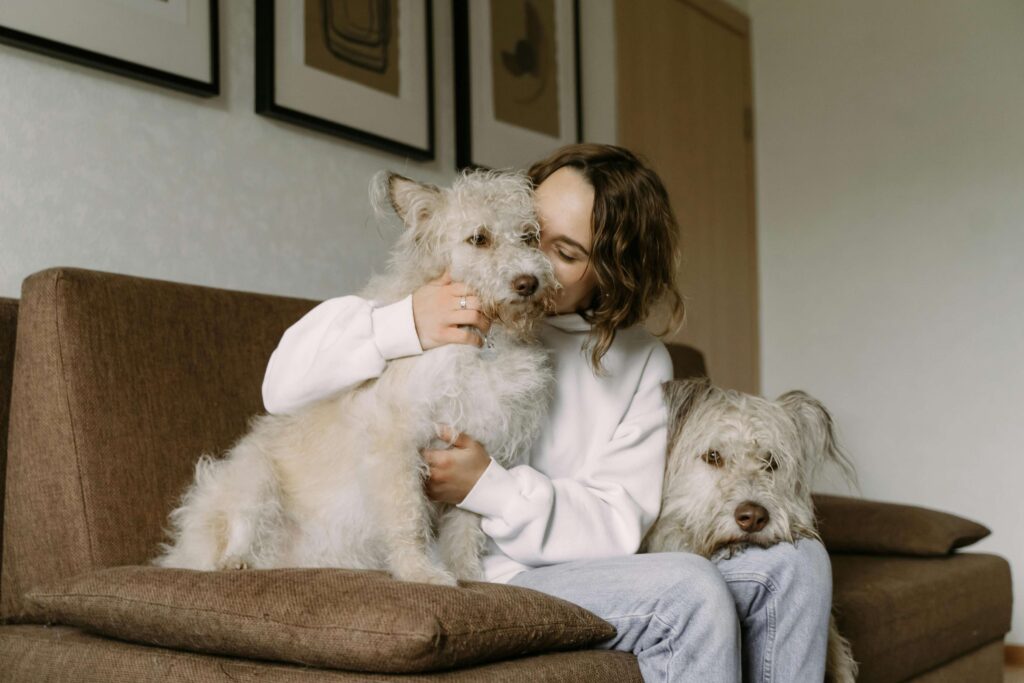Although they are great company, pets do not understand human language. Rather, they use actions, vocalizations, and body language to communicate. By being aware of these cues, you may strengthen your relationship with your pet and better meet their needs. We’ll break down typical pet behaviors and investigate what your pet may be attempting to communicate with you in this blog.
Body Language
One of the main ways that pets communicate their feelings is through body language. You may learn a lot about their emotions by observing their posture, tail movements, and facial expressions.
Dogs
Dogs’ tail wags don’t always indicate contentment. Whereas a high, rigid wag could suggest attentiveness or excitement, a gentle wag might suggest uncertainty.
Ears: While erect ears convey attention or inquiry, pinned back ears frequently convey fear or submission.
Posture: Your dog will feel safer if they are relaxed, but they may be stressed or aggressive if they are hunched over or rigid.
Cats
Tail Flicking: A swishing or flicking tail frequently conveys eagerness or annoyance.
Purring: As a self-soothing technique, cats may purr when they are happy or when they are in pain or under stress.
Ears and Eyes: While forward-facing ears and slow blinks convey affection and ease, flattened ears and dilated pupils may convey fear or hostility.
Vocalizations
Another method your pet expresses their needs and feelings is through sounds.
Dogs
Dogs Barking: Dogs may bark out of enthusiasm, attentiveness, boredom, or fear, among other emotions. To grasp the context, pay attention to the frequency and pitch.
Whining is a common sign that your dog is uncomfortable, anxious, or trying to get attention.
Growling is a telltale indicator that your dog is uneasy or feels threatened. When this happens, give them room.
Cats
Meowing: The main reason cats meow is to interact with people. While a low-pitched meow could convey discontent, a high-pitched one could convey a greeting or request.
Hissing: Hissing is an obvious indication of discomfort, fear, or hostility. In such cases, give your cat some room.
Trilling and chirping are frequently used to convey excitement or to invite others to follow them.
Common Behaviors
Dogs
Digging: Digging may be an instinctive action, a symptom of boredom, or an effort to relax.
Adult dogs may chew to relieve stress or boredom, while puppies chew to ease the pain of teething. To reroute this behavior, provide suitable chew toys.
Your dog is demonstrating trust and seeking solace by leaning on you.
Cats
Kneading is a reassuring habit that cats exhibit from kittenhood and is frequently referred to as “making biscuits.”
Hiding: When cats are anxious, afraid, or ill, they frequently hide. Make sure there are secure areas for them to go to.
Bringing “Gifts”: Your cat is showing you care and trust by sharing their “hunt” with you by dropping a dead mouse or toy at your feet.
Indications of Stress or Unease
You can treat your pet’s issues sooner if you can identify the symptoms of stress in them.
Dogs: Anxiety may be indicated by excessive pacing, drooling, panting, or destructive activities.
Cats: Stress might be indicated by excessive grooming, decreased eating, or increased vocalizations.
If you observe these behaviors, try to reduce their impact by identifying possible triggers, such as routine changes, loud noises, or strange surroundings.
Comprehending Play Behavior
Playing is an essential aspect of your pet’s life and a wonderful method to strengthen your relationship.
Dogs: Play bows are invites to play with the front legs extended and the back end up. While rough play, such as tug-of-war or wrestling, is common, keep an eye out for any indications that it’s getting out of control, such as growling or snapping.
Cats: Toys that simulate hunting activities include pursuing, swatting, and pouncing. To prevent scratches or bites, exercise caution while using your hands or feet as play targets.
Developing a Closer Bond by Comprehension
Your bond with your pet will become stronger the more you watch and comprehend their behavior.
Spend Time Together: Take your pet on walks, play with them, or just sit and do things they like.
Give people mental stimulation. Your pet’s mind is kept engaged with puzzle toys, training sessions, and novel experiences.
Have patience: Like people, pets have distinct personalities. Allow them time to adjust to novel circumstances or shifts in their daily schedule.
When to Get Expert Assistance
Unusual or persistent habits might occasionally be a sign of underlying mental problems or physical problems.
Health Concerns: A veterinarian should be consulted if there are abrupt changes in a pet’s appetite, energy level, or bowel habits.
Behavioral Issues: Seek advice from a qualified trainer or animal behaviorist if your pet exhibits aggressive, extremely fearful, or destructive behaviors.
Conclusion
The process of comprehending your pet’s behavior is continuous and calls for love, patience, and observation. You may better meet their needs and build a happier, more wholesome connection by being familiar with their distinctive communication styles.
Keep in mind that your pet is communicating with you through every meow, bark, purr, and tail wag. One of the most fulfilling parts of being a pet parent is accepting the learning process.
